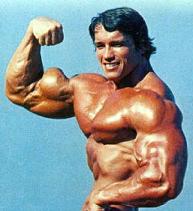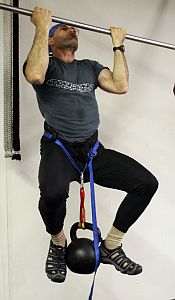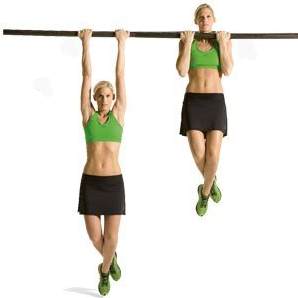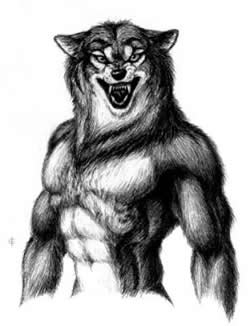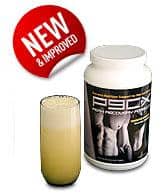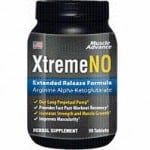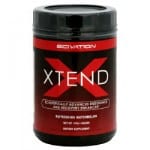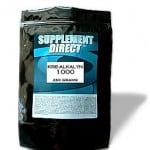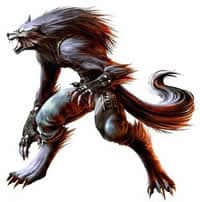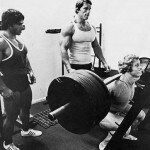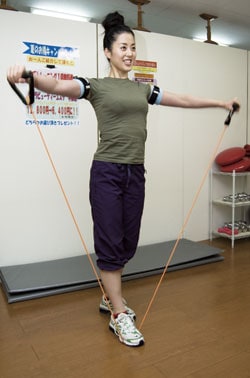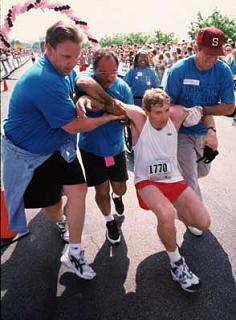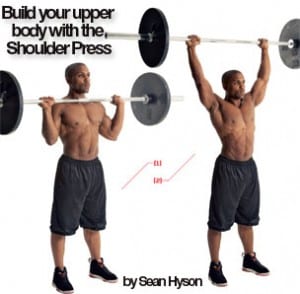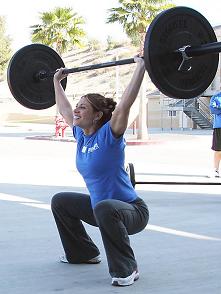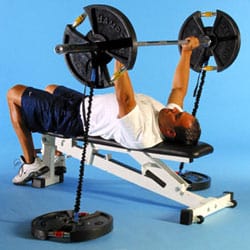Werewolf Muscle Training with Dumbbells
After many requests I’ve gone ahead and rewrote Werewolf Muscle Training without barbells. More specifically, this is a Werewolf Muscle Training style dumbbell routine to gain strength. Don’t get me wrong, you will still need at least an adjustable bench, and some exercises call for bands and medicine balls, but you can work around these requirements if necessary.
I can’t promise that this routine will be as effective as any of the original Werewolf Muscle Training routines, but I’m just giving you what you asked for. Please leave feedback in the comments or on the forum.
What Are Your Goals?
If you’ve come here to lose fat, you are better off using the Full Body Fat Loss Routine for Men or the Full Body Fat Loss Routine for Women. This routine definitely has nothing to do with fat loss, although some folks have adapted the diet to focus on fat loss instead of muscle gain. The choice is yours.
If you came to learn how to bench 700 lbs, you are better off reading Werewolf Muscle Training for Strength Gains. Although, truth to tell, you will get significantly stronger following this program.
Navigating Werewolf Muscle Training with Dumbbells
[ top ]
An Introduction to Werewolf Muscle Training
Werewolf Muscle Training is not designed to get you ripped, toned, conditioned, or even strong. You will get stronger as a side effect, but that was not the original intent. This is much more of a bodybuilding routine than anything else, but know that everyone using the original routine added weight to all of their lifts.
This is not for Olympic lifting, powerlifting, MMA, strongman training, or CrossFit, but the routine itself was designed for maximum muscle confusion, so you will get a taste of a wide variety of training philosophies. I’ve incorporated some optional HIIT and HIRT training for fat loss; neural activation training for warm ups, force development, and recovery; periodization and muscle confusion are the two main principles used throughout the bulk of this routine.
If you are a skinny guy and want to gain mass, this is for you. If you are ripped up and shredded but want to have more size, this is for you. If you just want to add 20-30 pounds of muscle to your body for whatever reason, this is for you.
I based this training routine off of my experience with personal training and sports nutrition, dating back to 1994. I’m no longer certified, but I know more now than I did back then… go figure.
My research on Taylor Lautner and how he trained to gain 30 pounds for his role as the werewolf Jacob Black in The Twilight Saga: New Moon is what actually prompted me to write up the original Werewolf Muscle Training routine.
Without further ado, let’s get into the principles of Werewolf Muscle Training.
Werewolf Muscle Training Principles
Weight selection:
When you see set protocols that look like 3 x 5, the goal is to use one weight for every work set. In this example you would use the same weight for 3 sets of 5 reps. If you can get the required number of reps for all sets, you should go heavier the next time you use that exercise. If the weight is obviously too light for you that day, feel free to increase it.
Choose a weight to start each exercise. If you think you can add weight and still complete the number of prescribed reps for the number of prescribed sets for that exercise, you may increase the weight between sets. HOWEVER – you should not have to decrease the weight at any time during the exercise.
Example: When doing bench presses, 4 sets of 5 reps, you start with 185 and get 5 reps easy. If you choose to go up to 200, you should use 200 for the rest of the exercise.
The max effort:
When you see set protocols that look like 5, 2, 1, 1, 1,… this is max effort attempt. The goal is to increase the weight for every set. Your 5 rep and 2 rep sets should not approach failure. For each 1 rep set you want to add at least 5 pounds to the previous set, until you believe you will fail if you add just 5 more pounds.
If possible you don’t want to ever fail at a max effort attempt, so it is advisable to stop short of a true max effort if it means you might not complete the rep, especially if you have already beat your numbers from the previous max effort workout.
Varying weights and reps:
Taylor didn’t stick to a 3×5 or 5×5 or 3×10 type of routine. He worked all of his muscle fibers equally by varying the volume from week to week. A study in the Journal of Strength and Conditioning found that strength can be increased by 28-43 percent just by varying rep counts and training different muscle groups.
It is still good to stick to a certain rep range based on your goals, but it is even better to occasionally change it up to force your body to adapt to new stimulus.
Number of sets:
When doing higher reps with lighter weight, you typically need fewer sets. Two sets of 10-12 reps is not uncommon.
When doing lower reps with heavier weight, you often need more sets. If is good practice to use four or more sets when training in the 1 to 5 rep range. A max effort attempt can use as few as 4 sets or more than 7. It all depends on the person and the day.
Reduce cardio to maximize muscle gains:
Taylor’s main goal was to gain 30 pounds of muscle mass. His metabolism was going to keep him ripped no matter what, so in order to gain muscle he had to cut back on cardio. If your only goal is to get ripped, HIIT cardio and HIRT are great schemes, but skinny hardgainers should minimize endurance training during a bulking phase. 20 minutes is the limit.
Note: For those who wish to add cardio, there is one HIRT session scheduled after every upper body workout. Using the HIRT session might decrease your overall muscle gain, but it will also minimize your overall fat gain and keep you in better cardiovascular health. Remember, the HIRT session is OPTIONAL.
Neural Activation Training (NAT)
Click here to learn more about NAT.
NAT workouts are optional, non-fatiguing, and will not lead to overtraining if used properly. NAT workouts will add to the effectiveness of the routine if you choose to use them.
Abdominal Training
The rules of weight training apply to the abdominals. It doesn’t make any sense to train your abs every day, if fact you need only train your abs a maximum of 3 times each week. For each ab workout we’ll pick a set of exercises that works the whole core and limit ab training to twice a week.
Abdominal workouts are scheduled on NAT days, but instead you can train your abs on any non-consecutive workout day. I recommend training abs on leg day if not on NAT day, but it’s your choice. All NAT and abdominal training options are listed in the routine and on the spreadsheet. Do whatever fits your schedule and recovery ability.
I have tried to limit the exercise selection to dumbbells and inexpensive equipment, which includes a box or bench, an ab wheel, resistance bands, and a medicine ball.
Resistance Bands, Chains, and Tension Training
Free weights are best, but we also want to occasionally added tension with bands. The added tension increases the difficulty of the easiest portion of each lift, which is usually at the top, by accelerating resistance at the end of each rep. Recruiting additional muscle fibers using this method definitely adds to the growth potential of each and every set.
Incidentally, bands are used in elite powerlifting circles like Louie Simmons’ Westside Barbell and Dave Tate’s Elite Fitness Systems. You may use them in conjuction with your exercises, to warm up, or as extra workouts to aid in recovery.
Click here to learn more about Resistance Bands.
You can find resistance bands at some gyms, but typically you will have to buy them on your own. Do not buy the resistance bands they sell at WalMart or Target, those are garbage. Go online and find real resistance bands that you can attach to free weight machines.
I have not specified more than one or two exercises that require bands, but you can use them with nearly every exercise if you desire. Bands are best used with the first couple compound exercises of the day. They can also be used with many of the other exercises. Your limitations will be set by your own creativity.
Varying planes of movement:
Most people train up and down, front to back. but side-to-side training is important too. Diagonal and sideways movements help to make a versatile training plan.
[ top ]
Maximizing Recovery
Recovery is so important to growth. Without recovery, you just can’t grow.
You will have the option of taking a day day off after every 2 workouts and an additional day on the weekend. Or if you have the time and resources, and if you are up to the challenge, you can use the prescribed NAT routines to enhance your recovery.
Follow these recovery tips to ensure proper muscular adaptation:
- Take every third day off from vigorous training. No max efforts or approaching failure.
- Limit intense training to 4 days a week. This does not include NAT or ab workouts.
- Weight training sessions should be kept under 60 minutes.
- Sleep for 7-8 hours each and every night unless you’ve mastered polyphasic sleep.
- Eat to gain, eat to recover. If you don’t eat right, your body will grow weak.
- Stretch for 10 minutes every every workout.
- Warm up for at least 5 minutes before every workout. No static stretching before intense training!
Recovery is important within a workout as well. We want each set to receive maximal intensity and muscular facilitation so we want to make sure your muscles are fresh for each set.
For regular weight training, follow these rest protocols:
- Supersets require no rest between sets. They will be denoted by a), b), and c). Only rest before a), never after a).
- 60-120 seconds rest between sets depending on your recovery ability. 90 seconds rest is generally enough.
- 2-4 minutes rest between exercises, as necessary.
Always end your workout with a 10 minute stretching session. Post-workout stretching increases both recovery and flexibility. This is a good thing.
Use these stretching principles:
- Read about Flexibility Training.
- Stretch every muscle group for at least one minute.
- Hold each static stretch for 20 seconds and repeat at least twice.
- Never use static stretching before you train.
- If you must stretch before you train, use only dynamic stretching.
- Think of your stretching session as a cool-down.
- Stretching does not count towards your 45-60 minute workout limit.
[ top ]
Nutrition – Eating to Grow!
You gotta feed the machine or it won’t grow. Here’s how.
Choose your goal weight.
For example, lets start with a 160 pound man who wants to weigh 180 pounds.
Calculate your metabolic co-efficient (M) based on your body type and past history of gaining muscle and losing fat. If you need help determining your body type, read A Body Type Analysis
- Endomorph (hard to lose fat, easy to gain muscle) – M = 8.5
- Mesomorph (moderately easy to gain muscle or lose fat) – M = 9.5
- Ectomorph (easy to lose fat, hard to gain muscle) – M = 10.5
Let’s consider that our 160 lb man is an ectomorph. He has always been thin with little to moderate muscle development, but it is difficult for him to really gain considerable muscle mass without drinking weight gain shakes all day long. His metabolic co-efficient (M) is 11.
Calculate total number of hours of training weekly.
If you are a busy guy you might be limited to three 45 minute sessions plus some warming up and stretching, which will come out to about 3 hours a week. For this example, at 5 days a week and 60 minutes a session, our man will be training 5 hours a week.
Daily Calories
Daily calories = Goal Weight X (the number of hours you workout per week + M)
Example: 180 lbs X (5 hours + 10.5) = 2790 calories per day
Daily Protein
You should get 1 gram of protein per pound of body weight each day.
Example: 180 lbs = 180 g protein per day (180 g protein X 4 calories = 720 protein calories)
The best protein powder you can choose for your Werewolf Muscle Training routine, is Optimum Nutrition. They have the highest quality protein for the cheapest prices. Click on this link to get some Optimum Nutrition protein powder now.
Daily Fat
You can estimate about half of your goal weight in healthy fats each day.
Example: 180 lbs = 90 g fat per day (90 g fat X 9 calories = 810 fat calories)
Daily Carbohydrates
The rest of your calories should come from high quality carbohydrate sources such as whole grains, vegetables, fruits, and legumes.
Example: 2790 calories – (720 protein calories + 810 fat calories) = 1260 carb calories (1260 carb calories / 4 calories = 315 g carbs per day)
[ top ]
Supplements to Enhance Your Workouts and Assist with Recovery
First let me say that you don’t need any supplements to succeed with Werewolf Muscle Training. Just eat a ton of the right foods, and you will grow. That being said, I know many of you will want to make the most of this routine by increasing your body’s capabilities with supplements.
Therefore, I am going to recommend a handful of the best supplements for you to use to gain muscle.
-
Post Workout Nutrition – P90X Results and Recovery Formula
Studies repeatedly show that you will recover from an intense workout twice as fast if you use a post-workout drink within 20 minutes of finishing an intense workout. It is a known fact at this point, so if you’re not using a specially formulated post-workout drink in that 20 minute window, then you’re throwing 50% of your gains right out the window.
This post-workout shake contains four parts carbs to one part protein, which is exactly what you need to ensure speedy muscle recovery after intense workouts. It tastes great, is all-natural, and contains no artificial flavors or sweeteners. Mix it with water in a shaker bottle right after your workout – quick and easy.
This specially designed post-workout shake contain a perfect blend of:
- Dextrose for optimum glycogen replenishment, a necessity after an intense workout.
- An easily digestible protein blend, providing critical amino acids to immediately restart protein synthesis.
- Antioxidants and vitamins, which help to reduce soreness and assist in tissue repair and muscle growth.
Click here to get some P90X Results and Recovery Formula for your Werewolf Muscle Training routine!
-
Nitric Oxide (NO) Supplement
N.O. supplements are some of the most popular bodybuilding supplements. N.O. will increase your pumps and, more importantly, increase your strength endurance. I find myself getting an extra 2-3 reps on every set when I’m using an N.O. supplement.
- This N.O. supplement is a Hemodilator, which gives you extra energy by pumping more blood through your body.
- N.O. supplements give you incredible pumps… you will look and feel stronger than ever.
- N.O. supplements increase levels of Nitric Oxide in your body, increasing both strength and endurance.
- By increasing your metabolism, N.O. supplements helps you avoid typical bulking-phase fat gains.
Click here to get some N.O. for your Werewolf Muscle Training routine!
-
Shakeology or Optimum Nutrition Whey Protein
Whey protein supplements can help you get the strong, powerful, lean, healthy body that you dream of. Hard-gainers can make higher carbohydrate protein shakes, while mesomorphs and ectomorphs can opt for the low-carb protein recipes. Click here for a list of more than 100 protein shake recipes.
First, check out Shakeology – it’s not just your average protein shake. Comes in two great flavors.
- Whole-food ingredients curbs cravings and burn stored fat
- Over 20 phytonutrients and antioxidants
- Reduces risk of high blood pressure, heart disease, and stroke
- Probiotics to assist digestion and nutrient absorption
Click here to purchase or learn more about Shakeology.
If you are looking for a pure protein powder, check out Optimum Nutrition. Optimum Nutrition protein powder comes in about 20 different flavors, and is available in 1 lb, 2 lb, 5 lb, and 10 lb containers.
- Make protein shakes to supplement your daily protein intake.
- Mix with foods you eat everyday to increase your daily protein intake.
- The amino acids in protein are the building blocks of muscle tissue.
- More calories = more muscle!
Click here to get some Optimum Nutrition whey protein.
-
Xtend Amino Acid Supplement
Xtend is a scientific blend of amino acids consisting of the proven 2:1:1 ratio of energy BCAAs (L-Leucine, L-Isoleucine and L-Valine), Glutamine, Citrulline Malate, and Vitamin B6 that will give you the energy you need to maximize your training and enhance recovery.
The components in Xtend have been scientifically proven to:
- help speed recovery
- enhance ATP production
- promote cell volume
- avoid fatigue
- increase protein synthesis
- improve immune function
- improve digestive health
- elevate growth hormone levels
- and promote vasodilation, which can lead to better assimilation and absorption of protein
Remember, Xtend is full of glutamine, which is an important amino acid for energy and muscle recovery. You can take a serving of Xtend before, during, and after any workout, as well as right before bed and first thing in the morning. A steady supply of amino acids can only do a body good. Just don’t drink so much that you make yourself sick of it! Trust me, I’ve been there.
Click here to get some Scivation Xtend for your Werewolf Muscle Training routine!
-
Creatine – Kre-Alkalyn
The purpose of creatine supplementation, is to build up the creatine levels in your muscles in order to increase strength and long term muscle gains, by more efficiently rebuilding ATP levels during your workouts. If you don’t know, ATP is what muscles use for short intense muscular contractions like weightlifting, sprinting, throwing, and jumping.
The good news is that Kre-Alkalyn has a higher absorption so it doesn’t require front loading and reportedly causes less creatine bloating and stomach problems. Kre-Alkalyn offers you a brand of creatine that is 100% stable, will not break down into creatinine, and will absorb efficiently into the bloodstream. Each gram of Kre-Alkalyn is equivalent to 10 grams of creatine powder.
The theory behind Kre-Alkalyn is: scientists discovered that the higher the pH of your creatine, the slower it is converted to creatinine. Pure Kre-Alkalyn has a pH of 12, the highest pH product on the market. This particular product also claims to use an enhanced delivery system, which gets the product into your blood stream even quicker.
Click here to get some Kre-Alkalyn for your Werewolf Muscle Training routine!
Your other options are to get regular old creatine monohydrate or creatine malate, which are both good, but reportedly not as good as Kre-Alkalyn. Just please do not get scammed by liquid creatine or creatine ethyl ester, or any of the other ‘advanced delivery’ creatine scams. That liquid stuff never works.
That’s just about all you need for supplements, although there are many other options available if you have the cash. The number of supplements you use depends highly on your budget and your willingness to drink shakes, juices, and take pills all day.
[ top ]
The Werewolf Muscle Training with Dumbbells Routine
Here is a 3 week, 21 day, 18 session workout routine designed to build muscle. It consists of 12 resistance training sessions, 6 neural activation training (NAT) sessions, and 6 ab workouts.
The latest version of Werewolf Muscle Training with Dumbbells is 1.0. I would like feedback on this routine if you try it.
First I’m going to list each exercise, then you can click on the link to view a printable HTML version, download an Excel spreadsheet, and hopefully in the near future I’ll be able to provide you with a PDF.
List of exercises:
Box jumps
Chin ups
Concentration curls
DB alternating lunges
DB bench press
DB deadlift lockouts
DB deadlifts
DB incline bench press
DB neutral grip bench press
DB one arm clean and press
DB one arm rows
DB pronated bent over rows
DB push press
DB reverse flyes
DB seated calf raises
DB shrugs
DB side raises
DB single leg Romanian deadlift
DB standing alternating bicep curl
DB standing alternating shoulder press
DB standing bicep curl
DB standing calf raises
DB standing OH triceps press
DB standing shoulder press
DB step ups
DB stiff leg deadlift
DB triceps OH press
DB walking lunges
Dips
Donkey calf raises
Glute-ham raises
Hammer curls
Lying DB cross-body single arm triceps press
Lying DB French press
Pistol squats
Pull thrus with bands
Pull ups
Reverse hypers
Seated calf raises
Single leg Romanian DB deadlift
Ab Training
Ab wheel roll outs
Bicycle maneuver
DB side bends
Flutter kicks
Fold ups
Medicine ball sit up toss
Reverse crunch
Russian twist
Sit ups
Vertical leg raise or captain’s chair
Windshield wipers
NAT Training
NAT Box jump
NAT Diamond plyo push ups
NAT Incline plyo push ups
NAT Inverted rows
NAT Jump squat series
NAT Plyo depth push ups
NAT Plyo push ups
NAT Pull downs with cables or bands
NAT Speed DB deadlifts
NAT Speed squats
NAT Vertical jump series
HIIT and HIRT Exercises
DB hang clean
DB hang snatch
Inverted rows
Jump rope jumps
Kipping pull ups
OH DB Squats
Push ups
Squat thrusters
Tabata Body Weight Squats
Wall balls
[ top ]
Printable Werewolf Muscle Training Workout Routines
A printable HTML document and an Excel spreadsheet is available for Werewolf Muscle Training with Dumbbells 1.0, and each update from this point forward. You can download them all at the link below.
Use these spreadsheets to track your progress. Either keep track of your numbers on the computer, or take the print-outs to the gym with you. A clipboard works great to hold your workout logs if you decide to print them out. I recommend using pen to record your numbers, as pencil fades over time.
Click this link to access the newest updated printable training logs.
Expected Results
I haven’t tested this program out over a long period of time, so I’m going to need a couple people to try it for at least 3 cycles, or 63 days.
I’m guessing a solid 10 pounds of muscle could be gained in less than a half a year using this program, as long as you stay disciplined with the routine, use proper recovery, eat right, and make good use of the supplements I’ve listed above.
After using this program for 3 cycles you should take one full active recovery (little to no weight training) week. Read more about active recovery here. You can also fill your week with NAT exercises, which make great active recovery workouts.
Happy gaining!
[ top ]
[ top ]







